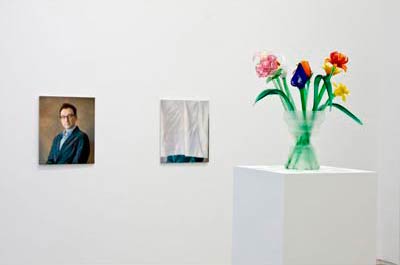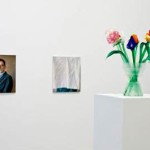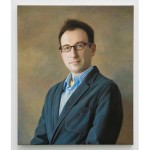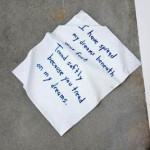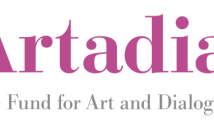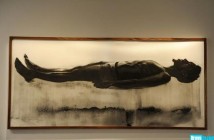2008 ICA FOSTER PRIZE FINALISTS: A CONVERSATION WITH JOE ZANE
On November 12th, the 2008 James and Audrey Foster Prize exhibition opened at the Institute of Contemporary Art, Boston. Joe Zane is one of the four artists competing for the $25,000 biennial prize, and Big RED editor James Nadeau caught up with him for a conversation about his work. This is part of a series of interviews with the Foster Prize finalists.
----
James Nadeau: One of the first things I want to talk about it process. Much of your work plays around conceptually with the notion of identity and image. I am thinking specifically here of your book and paper works but this also, obviously, extends across all of the media that you work in. Is the work, at its starting point, an exploration of the self that can ultimately lead to numerous places and mediums for you?
Joe Zane: I'm hesitant to say that is an exploration of the 'self' or at least of my-self. Even though I use my image a lot, it is 'image' that I am more interested in. The literal image - the thing you see - as well as image as an idea. Even this, though, is really more of a strategy then focus for me. I think what I'm really interested in is really broad questions, like what is the relationship between 'experience' and 'meaning.' If I had to describe a starting point for myself in a narrative way, it might go like this: you a see a thing, you know something about it because it's familiar... you've seen something like it before, then you learn something about the thing - or notice something about it - and the experience and meaning changes. The thing you were looking at is now different even though nothing REALLY changed. It's so simple and almost dumb really. But it’s something that I've always been totally fascinated by. It's almost like looking abstract painting.
JN: So it seems that you are interested in these concepts - the self, the image - in an almost phenomenological manner. Which I find fascinating especially considering the self-portrait plays such a large role in your work. Given what you have just said, however, this image could have been of anyone so it is as if you are offering up the image of yourself to viewers in order for them to have an experience. It is an interesting intellectual mobius strip. You are prompting these experiences using your image, which is what artists do. It just happens to be an image of the artist prompting it. Yet you are motivated purely by the image and not the fact that it is the self. Along those lines then, how did you approach the ICA Prize exhibition? Were these questions amplified due to the nature of the contest? I couldn't help but think as I wandered the galleries that all of you are investigating productions of the self in very different ways. Yet in some ways your work is very self-deprecating. I got these sense that you are also spoofing these concepts while investigating them.
JZ: While I say that I'm not really interested in the 'self' as much the image, it could not just be any person. It has to be me: me, the artist, me the maker. I think maybe the 'maker' thing is key. When I say I'm more interested in the image then the self, what I mean is that the image isn't personal. You aren't going to learn anything about me - at least nothing that I don't want you to learn. It isn't expressive or soul bearing. It is very on purpose, very made. So it's not that I'm not interested in it being me, I'm just not interested in it being ME - if that makes sense. You can think of it like, I make pictures of a character who just happens to share my name and look just like. And it's even more complicated because all of the things I put out there about this character are true. As for the phenomenological aspects, I think that is key to how the pieces function. So to get big wordy for minute, you could say that the work is a kind of ontological pursuit that operates in a phenomenological way. You could say that, it might be true depending on how good of a job I do. I said it in an easier way early when I said I'm interested in the relationship between experience and meaning. Now, as for how the ICA Prize exhibition affected the work, I think it's fair to say that everything got amped up, including the subtly and obliqueness. Part of it was the nature of the contest which I just couldn't ignore. But another more pragmatic part was that the show is up for a long time so I want there to be enough it to handle a sustained viewing and a wide array of audience. You know, a little something for everyone. As for the tone of it, it certainly is a bit self-deprecating, but that doesn't really mean I'm spoofing. Sometimes things seem logically to be contradictions or at odds, but they are true anyway. That is a big theme in my work. I think in the audio tour I said something like it's not this OR that, it's this AND that. Or you could say that it's about a relationship between this and that. But in order for the thing to be whole - the relationship - you need both parts to be equally there. So there is the relationship between me, the contest, the institution, art history, ego, humor, etc etc etc. Another contradiction that I find funny is that the more amped up or complicated the relationships got, the more straight-forward-looking the things became.
JN: I like the idea of it being an image that is not specifically YOU yet is simultaneously you. And, of course, how would one know that unless they know you? So it really is about layers of knowledge that is based upon experiences. Like you said, it is looking for meaning in an experiential moment, which is interesting in that this show, on a macro scale, is really about who the artists ARE. The nature of the exhibition and the prize is predicated upon a group of artists being something - specifically Boston-based. So right away you have meaning placed upon yourself and your work. You have to navigate the various relationships you have laid out - between you, the contest, the institution, art history, ego, humor, etc. etc. etc. It is inescapable. Yet you can disassociate yourself as these images exist away from you. They are now objects.
Let’s talk about specific work for a moment. First there are the painting cum portraits that you had commissioned. Can you talk a bit about the motivation there? I feel that these portraits transcend their nature as portraits due to the manner in which they have been created. Which is, once again, what we have been talking about. It is the YOU that is not you. There is a distance here that is quite compelling.
JZ: Those paintings were created by sending a single digital file via email to a business in China that has painters making paintings from photos. There is a lot there just in that gesture. I've used these painters before in order to produce paintings - art objects - without my hand in them at all. In this instance I wanted a portrait of me that wasn't like me at all. So I posed in this ridiculous stereotypical pose and looked at the camera. Then I sent the file and ask for two paintings. I asked for them to be exactly the same and I foolishly thought they would be. I liked the idea of there being two because when there are two you always look for which one is the real one or the first one or the better one. Well, when they came back they weren't the same. They are pretty darn close, but they are ever so slightly different. They hung up side-by-side in my studio for a long time and I never got over how strange they looked to me. In fact, those were the only pieces that I didn't make specifically for the ICA. They were already hanging on my wall when I was called about being selected.
Anyway, I think their strangeness comes exactly from the fact that they subvert portraiture, much less self-portraiture. A portrait is supposed to 'capture' a person, but mine do exactly NOT that. They look like me in a superficial way, but you don't learn anything about me. They are too flat, conceptually and also as paintings. And the fact that there are 2 makes it all the more confusing because the things that are the same about the paintings are the things that aren't really like me, if that makes sense. There is also this funny thing that happens because they are portraits in a place where self-portraits are expected. They take on a weird tone that I haven't quite nailed down yet. Do you know what I mean? But of course, this isn't the only reading of them, because, I think anyway, they are also interesting to look at it. They are nice paintings. And it seems so nice to have a picture - much less 2 - of the artist in a show that is supposed to be all about him -and really, the ICA prize show is supposed to be all about us... isn't it?
JN: And in some ways they are reflective of the way in which art can be delineated into that which is and that which isn't art. Their very "flatness" puts them in stark contrast to other types of portraiture, which emphasize exactness and fleshiness. In many ways they are reminiscent of portrait studio "portraits" which resist being denoted as "high art." Yet the context of your portraits elevates them to this level. What about the work that could be seen, in contrast to the paintings, as more conceptually grounded, for example the piece High Hopes? - a piece that in many ways is so far away from the portraits as to almost be from a completely different artist. Has this ever caused some consternation on the part of curators? I could see the frustrations in trying to encapsulate what you do when, although you are mining the same conceptual field, you are creating work that seems to be coming from two very different people.
JZ: When I was in grad-school, a professor of mine once told me that my work always looked like a group show. I'm not sure if he meant that as a compliment, but I loved that statement and have always kept it in mind when I work. Part of it might be that I was never one of those artists that had a 'style' and would then 'experiment in different media'. I'm more someone who gets an idea and then tries to make that be as good as it can possibly be without worrying about what my style might be. Another part of it though, is that I have a tendency to build a certain theatricality into my work. I sometimes think of the things I make as props or characters to some kind of theater that I'm trying to implicate the viewer in. So when thought of like that, it makes sense that the work might look like they were done by different people. Sometimes it extends beyond looking like art at all, but it might look like something I bought or found, such as when I display the books I've made, or sometimes it looks like something that was left there by someone else like the balloon hanging off the doorknob or like something has gone wrong in the space like the blinking light. All of that is important to set the tone for a show to me. As far as whether or not it's frustrating to curators, I guess I'm pretty oblivious to that. It might be, but I wouldn't know how else to behave. Hopefully I'm charming enough person so that it doesn't matter - that was sarcasm by the way... sort of.
JN: So, aside from curators, what are your thoughts on the works’ reception by visitors? The experience of your work definitely requires work on the part of the viewer. There is certainly an amount of winking at the viewer in your work but you don't lead one into it. It requires some effort.
JZ: Work that comes off as illustration or as didactic, I usually find really boring, but also the other end of the spectrum - work that hints or implies meaning without it actually being there, that also bores me, when things are too opaque as to not let you in, it turns into decoration or interior design. It is a really hard game, to figure out how much to leave in and how much leave out so that people have a chance discover things on their own. I guess I'm less interested in coming off as clever and more interested in letting viewers feel clever themselves - if that makes sense. I think humor might help too, it's nice to be able laugh at what you see and feel that's ok. So much of art viewing is just completely ridiculous but we don't feel like we have permission to laugh, it's nice to know you can laugh. I very rarely worry about the viewer though. Not that I don't think about an audience when I make things, on the contrary, I make things FOR an audience, it's made to be seen. I just don't worry about them 'getting it', it may be the one optimistic bone in my body, but I give the viewer a lot of credit. I have tremendous faith in their ability to read things. So much of the work I make relies on things having a kind of familiarity, that I almost take it for a given that the audience will be able to get it. They may not get every last detail, they might not get everything I packed in there, but there is enough there so they'll get something. Also, for me, the viewer completes the work - that's what I mean by ‘I make FOR the audience.’ When I think of what my work is or when I try to picture my own art in my head, it's never a picture of something; it's always a person looking at something, or a person a looking back and forth from one piece to another. I guess maybe that back and forth thing might be my work?
I've told a few people this story - A few people were worried that the blinking light was too subtle and that people might not see it or get it. First of all, that would be fine, there are lots of other things to look at it. But one day I was at the museum looking at my show, which is really hard to do undercover since my face is literally everywhere and everything was hung at my height - when I walk in the room it's like the last piece of puzzle getting put in. I was standing in the corner and I saw this couple notice the light flickering. They looked up at the flashy spotlight and then they looked back at the wall and noticed the hint of an outline on the wall. Then a little light bulb - pun intended - went off and they started laughing and pointing at the light and pointing at the wall. That made me feel really good. You can put something in a gallery that is barely there in every possible way and people will see it. This has nothing to do with my work, by the way, as much as I wish I could claim it as a success. I think it has to do the gallery itself. It's a kind of theatre for looking and discovery. People walking into a gallery and know they are going to be looking at something - and trying to figure out why they are looking at it.
JN: Do you want to talk about the glass pieces and how those developed? I don't want to harp on the breaking of Tulip Head but perhaps we can talk about the replacement piece and how the two differ?
JZ: That piece is a literal and figurative centerpiece of the show. It operates in a very formal way to tie the room together conceptually. That piece is positioned in the room in such a way as to line up with portraits of me. You have two ways of entering the gallery - one through Rania's show, the other through the Momentum show. Either door you walk through, you are presented with the same view - the vase in line with the portrait. I meant to be like a déjà vu. Also, as you probably know, the vase is a Rubin vase that is made from my portrait. I think I already mentioned that the paintings are all hung at my height, not the standard painting height, the vase is the same thing, it is presented at my head height. So, if I walk up to it, my face fits into it like a puzzle. However, there are actually 2 profiles looking at each other, and being in the 'round' as you walk around it, you are constantly presented with my 2 profiles. It's the literalization of a classic illusion, but it also about possibilities of looking. Not only is there the double of my 2 profiles, but also the double in the nature of the thing vase or face, or vase & face. I made it out of glass because I wanted it to be very precious and beautiful. I also wanted it to reference the Koons vase of flowers , which I love. The flowers themselves even carry a kind of double meaning, they can presented at a celebration or at funeral. Hmmm. I can say that the title, Tulip Head, comes from a Dutch saying for a crazy person and Doppelganger is probably pretty self-explanatory.
- Joe Zane, Installation view, Mixed Media, 2008.
- Joe Zane, Second, Oil Painting, 2008.
- Joe Zane, High Hopes, Plastic, 2008.
2008 ICA FOSTER PRIZE FINALISTS: A CONVERSATION WITH ANDREW WITKIN by MICAH J. MALONE in issue #95
The Institute of Contemporary Art
"The James and Audrey Foster Prize Finalists" is on view November 12th, 2008 - March 1st, 2009 at the ICA.
All images are courtesy of the artist and The ICA.

